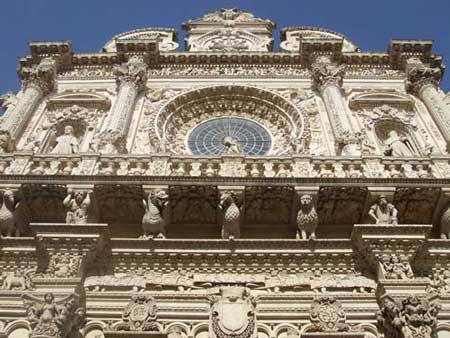About Lecce
Lecce is a riot of cherubs; the Baroque masterpiece of southern Italy. Sometimes described as the ‘Florence of the Baroque’ or the ‘Rome of the South’, Lecce is really the only city destination in mainland Italy south of Naples which is appealing enough to attract large numbers of tourists. It lies in the region of Puglia, down at the heel of Italy’s boot, surrounded by attractive countryside, seashore and small towns. The town is easy to reach by budget flights from the UK, and makes a good destination for a weekend break or a touring holiday.
Lecce’s history goes back a long way – you can still see ruins of a Roman theatre and amphitheatre – but the period which led to town’s current fame was the 17th century. A period of prosperity led to grand developments and the wholesale construction of palaces and churches. These buildings adapted the fashionable Baroque style to the soft local stone, with decorations and cherubs extravagantly covering facades and doorways. This local style is known as barocco Leccese (‘Lecce Baroque’).
Things to see in Lecce
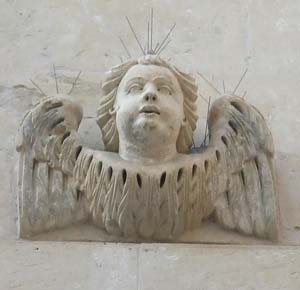
Lecce has a lovely historic centre (centro storico), and travellers can easily spend a day or two exploring picturesque little lanes and finding the more far-flung Baroque churches. The town’s great artistic treasure is its architecture; in terms of other arts, such as painting, Lecce cannot really compare with northerly towns like Florence and Rome. If you are planning to stay more than a couple of days, consider hiring a car or using public transport to make day trips, or moving on to a second, contrasting base like seaside Otranto or quaint Alberobello.
There are several’tourist information offices’ in Lecce, some of which are really not much more than shops selling local products. Most of these offices, including one in the old castle, will provide town maps (beware of confusion caused by maps which don’t orient north at the top of the page). The most useful information office we found was based in the police HQ in Piazza Sant’Oronzo, where an English-speaking policewoman researched buses with great thoroughness.
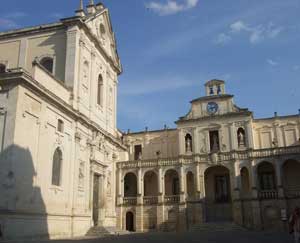
The most over-the-top decoration in town is to be seen at the Basilica di Santa Croce, which has a fantastical facade to marvel at, ornamented with strange beasts and allegories. As you wander you’ll also come across a couple of unfinished churches. Visitors will gaze at Lecce’s architecture with wonder, sometimes admiration or perhaps – if cherubs really aren’t your thing – with appalled fascination. How many ways can you carve a cherub, or putto? My personal favourite is a parade of putti carrying giant letters in a dedication written across the facade of Santa Maria di Costantinopoli.
The town has two main focal points: Piazza Sant’Oronzo and Piazza del Duomo. Piazza Sant’Oronzo is the big civic heart of the town, a large square with a slightly strange and incomplete atmosphere, the ancient and the modern sitting uncomfortably together. Among the varied structures here is the town’s excavated Roman amphitheatre. The statue of a bishop perched on a column represents Sant’Oronzo, a patron saint of Lecce. The column is one of two which originally marked the end of the Roman Appian Way in Brindisi (the other is still in Brindisi). Piazza del Duomo is an unusual interpretation of that familiar Italian cathedral square. In Lecce the cathedral sits in one corner of a theatrical enclosed square; a still space in the heart of town. Alongside is the high campanile.
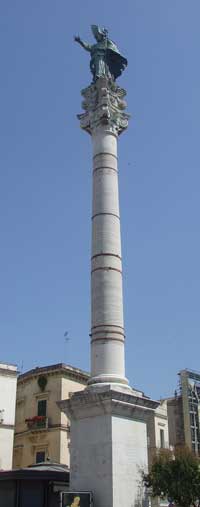
A good way to enjoy an initial introduction to Lecce’s centro storico is to take the little tourist ‘train’ (trenino) which offers a guided tour of the centre. Fun, useful or kitsch depending on your age, fitness and outlook, this is the single most obvious manifestation of tourism in the town as it parp-parps its way around the narrow lanes. You’ll see it pass, and you can hop on and off at various stops.
It’s worth visiting the Roman theatre and its little museum, in the centre of Lecce (Museo Teatro Romano, open Mon-Sat mornings). The town’s principal archaeological museum, the Museo Provinciale, has some interesting exhibits from Puglia’s long history, including Greek and pre-Greek ceramics. Entrance is free; the museum is located on Viale Gallipoli, not far from the railway station. It’s closed for an hour at lunchtime, and on Sunday afternoons.
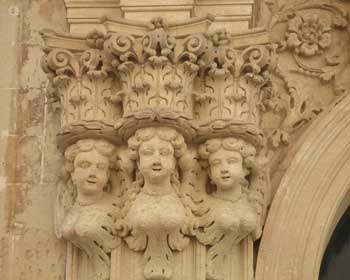
Lecce has a true southern rhythm. As the day heats up, the streets empty and during the hottest afternoon hours only a handful of overheated tourists can be spotted in the historic lanes. Churches and businesses generally close for several hours. Local people re-appear as the afternoon cools into evening, but the passeggiata hour here is later than northern parts of Italy. Smart youngsters, families with small children and the elderly all promenade the streets late in the evenings, with the town coming to life between eight and midnight.
Lecce food and drink
There is a reasonable selection of restaurants in the historic centre, and others in the streets beyond. Wandering along the central Corso Vittorio Emanuele and down Via Palmieri you’ll pass a choice of places for eating and drinking. One shop you must visit is Gelateria Pasticceria Natale, Lecce’s finest (and most popular) ice cream and cake shop. Situated just off Piazza Sant’ Oronzo, this is a temple of chocolate, gelato and pastry pleasures, and it is open from early morning until late at night.
Lecce travel
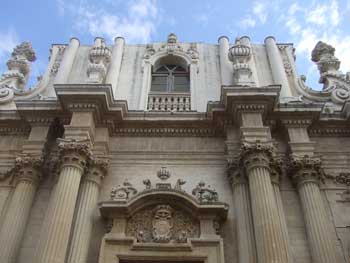
Lecce is very easy to reach from the UK. At the time of writing Ryanair operate budget flights to Brindisi Airport, just a few miles away. There is a direct coach service between the airport and Lecce, meaning the journey is quick and easy. The only drawback is that the bus stop in Lecce is a short way outside the city centre. The bus stop is grandly titled Lecce City Terminal, and boasts a small office with an air-conditioned waiting room. You could walk between the Lecce City Terminal and the heart of town, but it’s a fair distance and – depending on the location of your accommodation – it is likely to be a better option to take a bus. The number 21 ‘Navetta Foro Boario’ is a shuttle service which connects the big car park over the road from the Lecce City Terminal building with the castle, close to Piazza Sant’Oronzo. Buses stop alongside the car park, and also a short distance along the road into the centre (to the right), which is indicated by signs to the centro. The office at the terminal closes at 5:30pm at the time of writing; when open the staff should be able to provide you with any additional advice about reaching your accommodation.
Lecce is on Italy’s mainline railway network run by the Ferrovie dello Stato (FS) and so it is connected to most major towns in Italy. It is also served by a local rail service, called Ferrovie Sud Est (FSE) which runs slow but scenic little trains through inland Puglia. From Lecce you can take these trains to Gallipoli, Otranto and the towns of the Valle d’Itria: Martina Franca, Alberobello, Locorotondo and Cisternino. At Lecce station you’ll find the separate FSE ticket office on first platform up to the right as you face the tracks. At Lecce – unlike Bari – we found the FSE trains were listed on the station departures board. To reach the FSE platforms, we took the underpass to platform 5 and then crossed the tracks with care using the indicated crossing points. There is a left-luggage office close to the main station building follow the signs down to the left as you face the front of the station. STP city buses depart from outside the station the station bar sells both bus and regional rail tickets.
Buses run by a variety of different companies head out from Lecce to surrounding towns. These include a bus to Gallipoli which leaves from the Lecce City Terminal bus stop. A summer service called Salento in Treno e Bus runs connections between the area’s tourist destinations.
Around Lecce
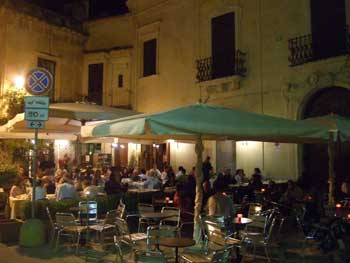
Lecce is sometimes described as having a beach, though the town lies several miles from the sea. The beach in question is a stretch of Adriatic coast at San Cataldo, with bus connections from the town centre. For a really nice seaside day out though, it’s worth travelling further, to lovely Otranto.
For a car-free touring holiday in Puglia, a good choice is to combine Lecce with a couple of the pretty towns along the FSE rail network. Alberobello is famous for its trulli houses while Martina Franca has a charming Baroque old town.
> Puglia & Matera – a travel itinerary
Lecce accommodation
Lecce has a few good hotels – including one smart and comfortable option in the heart of town – but it is most notable for its number of B&Bs. As the town has increased in popularity with tourists, many little B&Bs have been established among the Baroque buildings of the centre, offering affordable and atmospheric accommodation.
> The best Lecce hotels and B&Bs
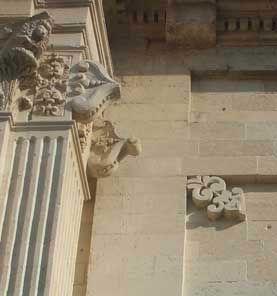
Useful external links
STP Lecce (buses)
